|
||||||||||||
|
It should be apparent that these are
personal choices influenced by my preferences. This
project evolved from my 50 best birds
in the world concept. I am foremost a birder, but I have been
fascinated with large mammals since I was a child. I have made numerous
special trips whose goal is to search for special beasts. There are
~11,000 birds in the world, and ~ 6,600 mammals, so it is not
possible to see all the birds or all the mammals within a lifetime.
Figuring out the "best 50" birds and mammals helps one sort out
priorities in travel. . . and is just plain fun. Links to my choices
follow, but do read more about the concept of this list following these
links. |
||||||||||||
|
As a birder who is prepared to try to identify any bird species in the wild, I have yet to become entranced by mammals that can only be identified through dentition formulas, or that are tiny and nocturnal and essentially impossible to see, despite their abundance. I did not wish to include groups that can only be identified by trapping and examination in-hand. So there are no mice, rats, shrews, gophers, moles, golden moles, marsupial moles, and other similar small species on this list. |
||||||||||||
|
I did not want to make this a list of the "rarest" mammals on earth. When I started this project, there were 1186 birds listed as threatened or endangered (Birdlife 2000) and 1179 mammals in a similar category (Burton & Pearson 1987). There are even more in those categories today. This means that about a quarter of the world's mammal species are rare. While a rarity is exciting, this category was not emphasized as much as qualities of uniqueness (i.e., is there another species like it?) and impressiveness. |
||||||||||||
|
The same problem applies to the lemurs of Madagascar. Ring-tailed Lemur (shown at top of page) is an absolutely fabulous mammal, but it's not "top 50." It is not rare enough, it is comparatively easy to see, and there is a fine variety of other wonderful lemurs on that magic island, quite a number of which are endangered. Only the largest lemur and the strangest lemur, both quite rare and each unique (in their own genera), made my list. Some indisputable unique and very interesting mammals did not make the list, including Giraffe and Hippopotamus shown in the opening photos. It is just that when thinks of the first trip to Africa, almost everyone wants to see a lion, leopard, elephant, rhino — it is just that hippos, giraffes, gnus, a parcel of antelopes, jackals, and warthogs are further down the 'want list.' The latter are just "too common" or "too easy" for the Top 50. Some will argue that lion, leopard, and elephants are also "common" or "too easy," and basically that's true enough if you pay for a high-end African safari. Yet they are so special and so impressive that their comparative "easy" status is not that important: they are iconic. I've spent plenty of days in habitat without seeing a lion, for example — it may be comparatively "easy" but no trip is complete without one. The "King of Beasts" is Top 50 material in my book. Big, impressive, or dangerous animals are the most memorable for me. I readily admit to a special affinity for big cats, great apes, rhinos, and huge whales. They impress me a lot more than typical grazers or rodents or raccoons. All seven big cats made my list; the four great apes are all here; and four picks went to rhinos. This means that almost a third of my choices are scattered among just three groups. Yet I am willing to make special trips and searches for these impressive mammals, something I cannot say is true for any rat, rabbit, or mole. In contrast, there is just one canid and two antelope. I do include three bears, one seal, one pig, and five cetaceans, plus such absolutely unique mammals as Aardvark, pangolins, colugos, a monotreme, an armadillo, a Madagascar carnivore, and four marsupials. I did not choose any species that is heavily domesticated — no camels*, no wild ass or horse — nor did I include species whose population now consists almost entirely of re-introduced animals (e.g., White Rhinoceros, American Bison). Still, I regret there was not space to include any civet, otter-shrew, or wild goat — there are very interesting species among these groups.
|
||||||||||||
Finally, I wanted to highlight diversity around the globe. There are many tropical mammals included but also some long-distance migrants and some species of the cold north. A dozen of the picks have ranges across several continents or oceans, but the rest of my choices are essentially distributed as 11 in Eurasia, 11 in Africa (plus 3 more in Madagascar), 6 in the Neotropics, 3 in Australasia, 5 entirely pelagic, and 2 polar ice shelf. The remaining 9 inhabit multiple continents (e.g., 3 cats, a bear, a weasel, elephants, tapirs, pangolins, manatees). There is a good deal of literature about mammals that is worth reading. I used Macdonald (1984) and many specialized field guides in researching mammals, as well as the first volume of the Handbook of the Mammals of the World. On-line resources also often had updated information on specific mammals. Jon Hall has the best mammal-watching site, with trip reports from around the world. Click on the button-link below. |
||||||||||||
There is no right answer to the question: what are the 50 best mammals of the world? In fact, I've made small modifications to my own list here over the last 25 years. A "top 50" list by an active field mammalogist — someone who is more interested in mammals than in birds — would be a different list, and in many ways a better one. When I started this project in 2002, I asked Vladimir Dinets and Jon Hall, both widely traveled field mammologists, for such a list of best mammals. Vladimir sent a "top 50" list and Jon a "top 30." I also asked another birder with a passion for mammals, Blake Matheson, and he graciously agreed to do so as well. It is very interesting to compare and contrast their picks (use the link below). This is not a list of the rarest and most endangered mammals of the world. While the concept of "how rare" is a particular mammal enters into the evaluation process (see below), in this project that quality is balanced against other qualities. For a list of the most endangered mammals, see the EDGE project (Evolutionarily Distinct and Globally Endangered species; click on the button-link below). I was unaware of that project when compiling my own list, so I have not been influenced by their rankings. Some years ago, the EDGE project published a list of the "top 100" most endangered mammals. That list is apparently not on-line now, but at the time the EDGE 100,included 15 rodents, 11 bats, 5 moles, 4 rabbits, and 3 shrews. Indeed, small mammals account for about half of the world's rarest beasts. These mammals are quite interesting, but they are not typically found among those I consider the "best" mammals in the world. Size and ferocity are often qualities of my "best" mammals. I do note, however, that 3 rhinos are found in the EDGE's top 11 choices; I have 3 rhinos within my top 20. At the time, EDGE included Yangtze River Dolphin (Beiji) Lipotes vexillifer as #5 on their list of rare mammals. In my listing it was not considered, since species that are extinct or are on the verge of extinction were not considered. This also goes for the unique Saola Pseudoryx nghetinhensis, a mysterious forest bovid ion the Vietnam/Laos border. Not discovered until 1992, antelope appears to be functionally extinct, as, to my knowledge, all recent efforts to find it have failed. |
||||||||||||
|
LITERATURE CITED:
|
| TOP Page created 1-6 June 2002, revised 30 Aug 2010, 7 Dec 2014, 18 Feb 2021, and 27 Sep 2025 |
|
photos & text © Don Roberson |
HOME |


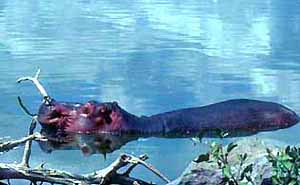
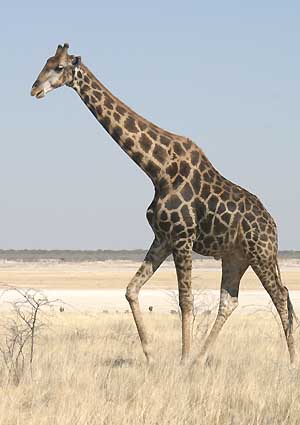
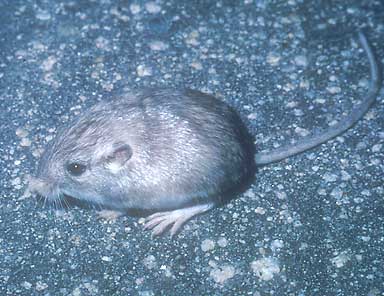 The idea of this project was to
weigh and balance how impressive, how unique,
how rare, and how hard to find each
extant species is, and consider any special circumstances
surrounding that species. Lions and tigers
were the stuff of dreams as a child, but a species' history or mystery
can also come into play. I also wanted to ensure a diverse selection
across continents and oceans, and throughout the spectrum of mammal
biodiversity.
The idea of this project was to
weigh and balance how impressive, how unique,
how rare, and how hard to find each
extant species is, and consider any special circumstances
surrounding that species. Lions and tigers
were the stuff of dreams as a child, but a species' history or mystery
can also come into play. I also wanted to ensure a diverse selection
across continents and oceans, and throughout the spectrum of mammal
biodiversity.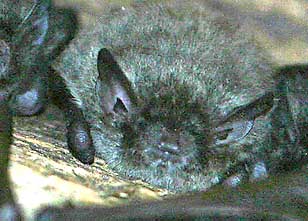 On the other hand, 20% of all mammals on earth
are bats. I enjoy bats very much, and have added an "extra" category for them at the end of my list of fifty. Bats can be very difficult to identify in the field, but
progress is being made on field identification by size, behavior, and
echolocation calls, and roosting bats can often be sorted out.
On the other hand, 20% of all mammals on earth
are bats. I enjoy bats very much, and have added an "extra" category for them at the end of my list of fifty. Bats can be very difficult to identify in the field, but
progress is being made on field identification by size, behavior, and
echolocation calls, and roosting bats can often be sorted out.  Everyone wants to see a kangaroo
in Australia sometime in their life [Gray Kangaroo, right, with joey].
The problem is that there are something like 50 species of kangaroo and
wallabies in 11 genera, ranging from big red ones to small
tree-climbing ones, and there are many species that are similar to
other species. The biggest and most impressive ones are neither rare
nor hard to see, and the smaller, rarer ones often resemble other, more
common, species. So no Australian kangaroo made the "top 50," although a relatively recently discovered tree-kangaroo in New Guinea is on the list.
Everyone wants to see a kangaroo
in Australia sometime in their life [Gray Kangaroo, right, with joey].
The problem is that there are something like 50 species of kangaroo and
wallabies in 11 genera, ranging from big red ones to small
tree-climbing ones, and there are many species that are similar to
other species. The biggest and most impressive ones are neither rare
nor hard to see, and the smaller, rarer ones often resemble other, more
common, species. So no Australian kangaroo made the "top 50," although a relatively recently discovered tree-kangaroo in New Guinea is on the list.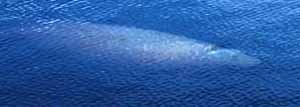 I did permit myself one option
that served to expand the picks somewhat. I was able to chose "any
unicorn" if there were two or more such unicorn
species that were closely related (usually the same genus) and if each was about rare, impressive, and/or hard-to-find. There are
9 such choices in this top 50 listing. Most all involve species
within a single genus, but I did expand "any pangolin" to the entire family Manidae, and did expand the concept to include "any sirenid" as a single pick:
these are the 3 species of manatee plus the South Pacific dugong.
Together this might be considered the "sea cow" pick (my above-water
shot of West Indies Manatee is above left).
I did permit myself one option
that served to expand the picks somewhat. I was able to chose "any
unicorn" if there were two or more such unicorn
species that were closely related (usually the same genus) and if each was about rare, impressive, and/or hard-to-find. There are
9 such choices in this top 50 listing. Most all involve species
within a single genus, but I did expand "any pangolin" to the entire family Manidae, and did expand the concept to include "any sirenid" as a single pick:
these are the 3 species of manatee plus the South Pacific dugong.
Together this might be considered the "sea cow" pick (my above-water
shot of West Indies Manatee is above left).